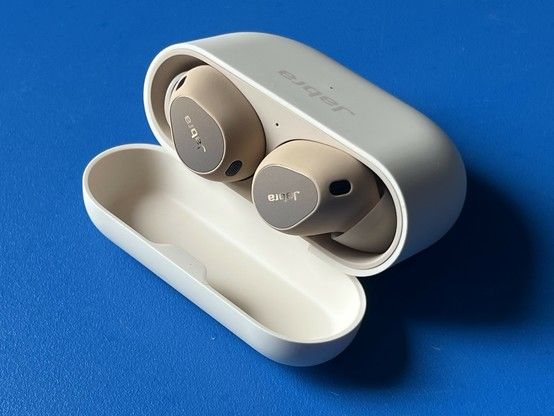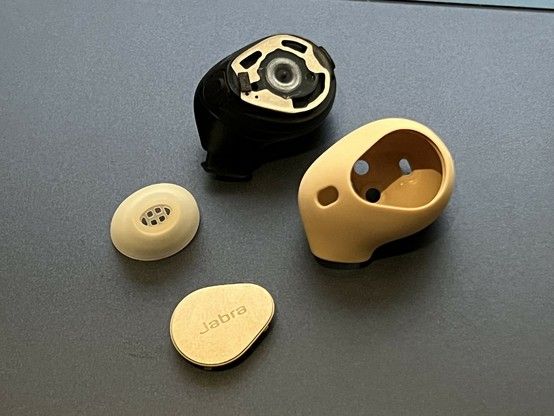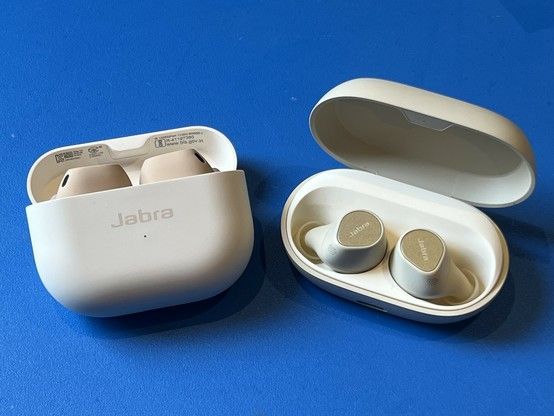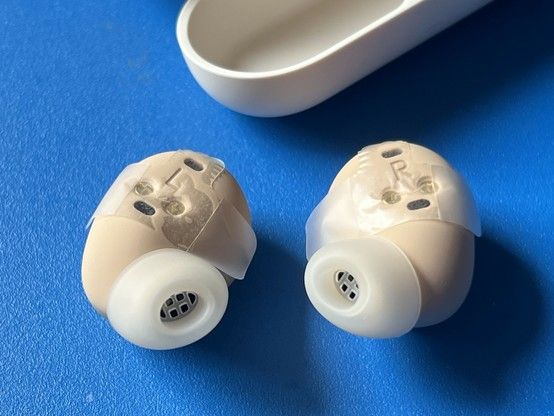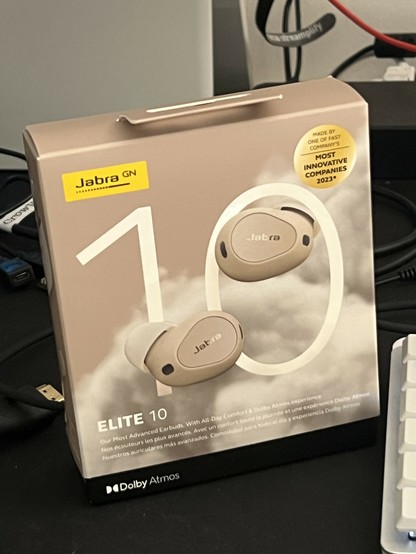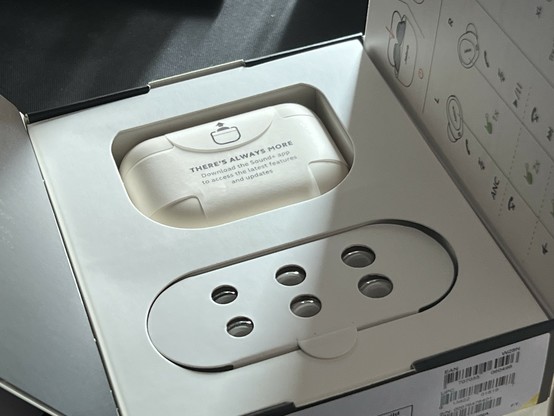Jabra Elite 10 Earbuds Reviewed
Soon after I wrapped up my review for the Jabra Elite 7 Pro, Jabra’s Elite 10 thundered onto the scene- making a mockery of the modest few complaints I had about their predecessor.
The Elite 10 have undergone a surprising number of changes from the 7 Pro, though at a glance it’s clear that both of these earbuds are cut from the same cloth and, indeed, I’d still recommend the 7 Pro as a very keenly priced and highly competitive alternative.
Jabra Elite 7 Pro vs Elite 10. Quite a world of difference, but clearly cut from the same cloth.
Where the Elite 10 excel most, however, is comfort and for that reason alone they are well worth considering. The redesigned ear-tips are branded as “semi-open” which is a roundabout way of saying they give up some passive noise cancellation and some of the fabled “Good Seal” (ostensibly required for good quality audio from earbuds) for a looser, more comfortable fit that puts less pressure on the inside of the ear. It works. It works superbly well. Where every other earbud I’ve tested to date has inevitably caused quite significant irritation, the Elite 10 are comfortable. So comfortable that I’ve fallen asleep wearing them, listened to the low battery warning, woken up to them running completely out of battery, and just been too half-asleep to even bother removing them. And when I say “them” I really mean “just the left one.” It’s a shame, then, that trying to sleep on my left side inevitably presses too hard on the button and turns off the earbud. D’oh. These could be great sleep earbuds if there were some secret power-off button combo instead, or if I couple just disable the long-press-to-turn off. (Who turns their earbuds off, c’mon, really?)
But comfort is far from everything that’s changed.
Build Quality, Look & Feel
I received the Elite 10 in “beige”, and I can most liken the colour to “sun-aged retro computer.” I’m sure I’ve tried to “retrobrite” a Commodore 64 out of the same shade of beige. They are very notably darker than the 7 Pro, and the case is lighter. They still look great and the matte gold button with the “Jabra” logo picked out in gloss. It looks great, and in keeping with the darker shade of beige the gold tends a little toward rose. Not all the way, though, just a little.
The beige Jabra Elite 10 are extremely “old computer” beige. Notably darker than their enclosure and the Elite 7 Pro. I’m pretty sure I’ve partially restored a Commodore 64 from this colour 🤣
Marring the beige surface somewhat are the tiny, black microphone grilles. There are two on each earbud, on the top and bottom.
The Elite 10 are the first earbuds I’ve tested that involve a two-piece construction, consisting of a hard, inner plastic and a soft, silicone rubber outer coating protecting it. This coating isn’t fixed in place, however, and can – with some persuasion – be completely removed, allowing any grime that’s crept in and around it to be cleaned away. A little more persuasion will separate the button from the top of the earbud, but there’s nothing interesting hidden underneath. Getting the rubber coating back in place is also, surprisingly, easy. I’d wager swapping out the button and outer coating is how Jabra can produce so many colour options. Alas, while you can buy a set of four new tips/ear gels you can’t get replacement silicone coatings to swap out your colour!
Not me discovering that the entire outer coating of Jabra’s Elite 10 Pro is a removable, silicone rubber sleeve.
This is in stark contrast to the Elite 7 Pro with which I had difficulty even removing and replacing the silicone ear tips. That’s fixed in the Elite 10, too, along with offering extra comfort the new tip shape is much, much easier to pry off and replace. In fact Jabra have even added tiny, coarse silicone grills to the tips in order to catch any stray ear detritus and keep it from getting lodged in the speaker. It works, too, and can be easily cleaned with a dry Q-tip or removed for a more aggressive clean.
Where are my LEDs?
It’s not all roses. The Elite 10 lack the tiny, individual indicator LEDs that I liked on the 7 Pro. If you’re in the habit of using a single earbud, that at-a-glance view of which one is fully charged is missing in favour of a streamlined design. I’m going to have to concede that it wasn’t *that* useful a feature, but I did love that they managed to hide tiny LEDs underneath the buttons. In lieu of these the Elite 10 have two LEDs on the case. One outer status LED on the “front” (or the top, I suppose, it’s an odd shaped case) and one LED between the earbuds when you open the lid. It’s clear by confirming with app that these represent the charge level of the case and earbuds respectively with the LEDs progressing through Green, Amber and Red as the battery drops below certain thresholds.
The case for pocketability
The Elite 10 case is very reminiscent of the Sony XM5 case. It’s thinner than the Elite 7 Pro case, though it may be roughly the same size by volume, and has fewer sharp angles. This makes it significantly more pocketable though it’s a little prone to picking up marks from my keys. Yes, yes, I know, I should be more careful what I put in my pockets.
The flatter, thinner, taller case is a little more pocket friendly.
The thin, tall design with a narrow flip-top also means it’s much more natural to grasp and open with one hand- holding it with two fingers and flipping the top open with a thumb. It is, however, a little tricker to grab an earbud with that same hand but it can be accomplished with practice. “Why would you want to operate an earbud box one-handed?” you might ask. Well, I’m effectively one-eared so I assume not everyone is availed of a full set of appendages.
Moving on from its accessibility, the Elite 10 case is a little odd. Where the Sony XM5 is similarly tall and narrow, with a flat bottom that lets it stand proudly upright, the Elite 10 are content to lie down. This could be some 4d chess meta flex from Jabra, since their buds are better in many ways, but it feels like they deserve to stand upright too. The “bottom” (or I suppose the front) instead has a USB Type-C port for charging and – if I think about it – that’s a wide open door for a great little plug-in, table-top dock solution. Such a thing isn’t necessary, though, since – like basically any earbud case worth its salt – the Elite 10 case also includes wireless Qi charging and has worked fine on my UGREEN Nexode and any other charger it can sit on top of.
Unlike the Elite 7 Pro’s fancy embossed Jabra logo, the branding is a little more subtle here, but the inside of the case is similarly lined with soft-touch silicone rubber that will keep the earbuds pristine. Though only time will tell if the rot sets in!
Single-sided accessibility
One feature I’m glad not to lose from the Elite 7 Pro is Jabra’s excellent software. It carries across their range, and so far the features between both have been pretty consistent. Most important to me is the ability to re-assign the press/double-press/triple-press actions on the left earbud to give me ANC control and audio play/pause on a single side. Other brands restrict you to having controls on specific earbuds, which is a nuisance if I can only use one.
In order to preserve battery life – and to dispel the “wow factor” that the switch from “hear-through” to “ANC” inevitably creates – I configure a single press on the left button to cycle through ANC, Hear-Through and Off. The latter is not enabled by default, but in most cases – and even with the “semi-open” design – the passive noise isolation is good enough that ANC is unnecessary.
The Elite 10 opt for a physical button instead of the fairly common touch sensitive design and in many ways I prefer it. It’s slightly more difficult to accidentally press a physical button, versus brushing against a touch sensitive one, but it’s also easier for that button to be pressed when – for example – it’s squashed between your head and a pillow.
When using a single earbud the Elite 10 will downmix any stereo audio to mono, which is useful since I’m used to headphones where I must use “Mono Audio” toggle in iOS’s Audio/Visual accessibility settings.
Unfortunately this mono downmix doesn’t handle Left/Right phase cancellation, so it’s entirely possible in some obscure cases to have no audio whatsoever when whatever you’re playing hasn’t been carefully engineered with the possibility of mono downmix in mind. That said, this is a rare occurrence and I only know it happens because I know exactly what to look for. It also happens with iOS’s mono downmix and is quite a tricky problem to solve- that is; I have no idea if it’s solvable or how you might do so. Through my hazy memory I recall only ever encountering this problem in one single solitary YouTube video. Don’t sweat it. Stereo to Mono downmixing is complicated!
Water Resistance
Like the Elite 7 Pro I took Jabra’s claims at face value and wore an Elite 10 bud into the shower for crystal clear podcast listening while I attempted, futilely, to break it. What, am I supposed to just shower in silence?
The silicone rubber tips not only have grilles - notably missing from the Elite 7 Pro - but are much easier to remove and replace.
I found the Elite 10, with its “semi-open” fit, a little easier to dislodge under these extreme conditions, and it fell into the bottom of the shower at least once. Fortunately no harm was done, and as winter sets in – I got caught in the rain today – I’ll be glad to have some earphones that can survive adverse weather as I inevitably slog my way out to find something for lunch in the Tesco sale sections.
Another downside of the “semi-open” fit is that water tends to work its way into my ear during a shower. If you, uh, don’t plan to shower and wash your hair while wearing these it’s a problem you will never encounter.
Noise Isolation
The “semi-open” design is a little like the difference between open-back over-ear headphones and fully closed ones. You’ll hear more background noise when ANC is off and the Elite 10 sound, and feel, less like wearing earplugs. There’s rather a lot less difference between “Off” and “Hear-through” even with the volume cranked, and it’s only through dragging the “Hear-through” volume in the Jabra app that I could convince myself it was doing anything at all. This could be a nuisance if you find yourself wearing both buds and needing to converse with someone. More often than not I need to remove a the earbud to hold a conversation, so I’d actually prefer “Hear-through” to provide a lot more amplification.
As with most other (decent, anyway) ANC, the Elite 10 fare decently at cutting out fan noises and the dull roar component of travel noise, but their lack of passive isolation means they fall short of the Elite 7 Pro to my ear. The critical benefit, however, is that I cannot wear the 7 Pro, or any other earbuds I’ve tested to date, for the hours and hours that I can comfortably wear the Elite 10. In any case, even moderately low audio, a podcast or some ambient sounds from the Jabra app’s “Soundscapes” feature will easily mask the remaining noise.
Unlike the 7 Pro there are no noise cancelling or sound personalisation settings, and no fit testing (since the semi-open design would likely render it redundant). It’s good to know that the “Pro” moniker means you’re getting something extra – in theory – but it’s a shame that these features haven’t made it into the Elite 10 and paved the way for an Elite 10 Pro to raise the bar even higher. Whew that’s some mixed metaphors.
Jabra have a habit of updating their software with new features and improvements – I’ve seen multipoint added to the 7 Pro, and audio-over-USB Type-C added to the Evolve2 (85, IIRC) so it’s not unreasonable to suggest a software update might push the 10 Pro further. We’ll see.
Overall
The Elite 10 are earbuds I can wear all day every day with very little irritation. I love them. It’s actually rather difficult to remember to put these down and thoroughly test the other earbuds and headphones I’m supposed to be working through. Yes, despite coming up short on fancy features and having slightly weaker noise cancellation than the 7 Pro, they’re that good. The sleek case is pocket friendly. The water resistance (even the case is modestly water resistant) makes them suitable for rainy days, showers and intensive workout sessions.
The packaging is quite bulky and very showy, it could definitely be smaller and involve less printed surface.
It’s a small consolation given the £200-£300 price tag of top tier, noise-cancelling earbuds, but among their more expensive contemporaries Jabra’s Elite 10 remain the best value of the bunch.
Uh, that is with the notably exception of the 7 Pro. If you don’t have issues with earbud comfort and don’t mind a slightly awkwardly shaped case, the Elite 7 Pro are still a very strong contender and can be had for around £120. You can read my review of the Elite 7 Pro here.

